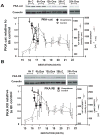Changes in rat myometrial plasma membrane protein kinase A are confined to parturition
- PMID: 20457802
- PMCID: PMC2893254
- DOI: 10.1177/1933719110368869
Changes in rat myometrial plasma membrane protein kinase A are confined to parturition
Abstract
We have previously shown that pregnant rat myometrial plasma membrane-associated cyclic adenosine monophosphate (cAMP)-dependent protein kinase A (PKA) decreases prior to delivery, coincident with a decline in the inhibitory effect of cAMP on contractant-stimulated parameters. We now find that rat myometrial membrane-associated PKA concentrations in early to mid-pregnancy are equivalent to those in cycling rats. Following the decline associated with parturition, membrane PKA recovers within 1 to 2 days postpartum. Treatment with the antiprogestin onapristone caused a decrease in myometrial membrane PKA catalytic and regulatory subunits compared to untreated controls by 12 hours. This coincided temporally with recently reported increases in electrical and contractile activity. In unilaterally pregnant rats, the decline in plasma membrane PKA was observed in both nonpregnant and pregnant horns but was more rapid in the pregnant horns. These data indicate that the myometrial plasma membrane PKA pattern before and during most of pregnancy is not consistent with progesterone exerting a primary influence on PKA membrane localization. Rather, the fall in membrane PKA associated with parturition may contribute to or be influenced by the increased contractile and electrical activity of labor that is a consequence of the loss of progesterone influence and is not absolutely dependent on the presence of fetuses.
Figures



Similar articles
-
Progesterone prevents the pregnancy-related decline in protein kinase A association with rat myometrial plasma membrane and A-kinase anchoring protein.Biol Reprod. 2002 Aug;67(2):605-9. doi: 10.1095/biolreprod67.2.605. Biol Reprod. 2002. PMID: 12135903
-
A role for AKAP (A kinase anchoring protein) scaffolding in the loss of a cyclic adenosine 3',5'-monophosphate inhibitory response in late pregnant rat myometrium.Mol Endocrinol. 1999 Dec;13(12):1977-87. doi: 10.1210/mend.13.12.0378. Mol Endocrinol. 1999. PMID: 10598575
-
Human myometrial quiescence and activation during gestation and parturition involve dramatic changes in expression and activity of particulate type II (RII alpha) protein kinase A holoenzyme.J Clin Endocrinol Metab. 2003 May;88(5):2194-205. doi: 10.1210/jc.2002-021862. J Clin Endocrinol Metab. 2003. PMID: 12727975
-
Transcription factors regulated by cAMP in smooth muscle of the myometrium at human parturition.Biochem Soc Trans. 2021 Apr 30;49(2):997-1011. doi: 10.1042/BST20201173. Biochem Soc Trans. 2021. PMID: 33860781 Free PMC article. Review.
-
Molecular signaling through G-protein-coupled receptors and the control of intracellular calcium in myometrium.J Soc Gynecol Investig. 2005 Oct;12(7):479-87. doi: 10.1016/j.jsgi.2005.07.002. J Soc Gynecol Investig. 2005. PMID: 16202924 Review.
Cited by
-
The influence of maternal body mass index on myometrial oxytocin receptor expression in pregnancy.Reprod Sci. 2013 Dec;20(12):1471-7. doi: 10.1177/1933719113488446. Epub 2013 May 7. Reprod Sci. 2013. PMID: 23653389 Free PMC article.
References
-
- Challis JRG. Mechanism of parturition and preterm labor. Obstet Gynecol Surv. 2000;55(10):650–660. - PubMed
-
- Sanborn BM. Hormones and calcium: mechanisms controlling uterine smooth muscle contractile activity. The Litchfield Lecture. Exp Physiol. 2001;86(2):223–237. - PubMed
-
- Havelock J, Keller P, Muleba N, Mayhew BA. Human myometrial gene expression before and during parturition. Biol Reprod. 2005;72(3):707–719. - PubMed
-
- Shynlova O, Tsui P, Jaffer S, Lye SJ. Integration of endocrine and mechanical signals in the regulation of myometrial functions during pregnancy and labour. Eur J Obstet Gynecol Reprod Biol. 2009;144(Suppl 1):S2–S10. - PubMed
Publication types
MeSH terms
Substances
Grants and funding
LinkOut - more resources
Full Text Sources

